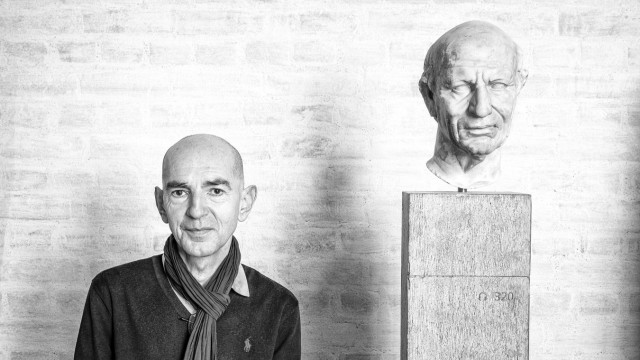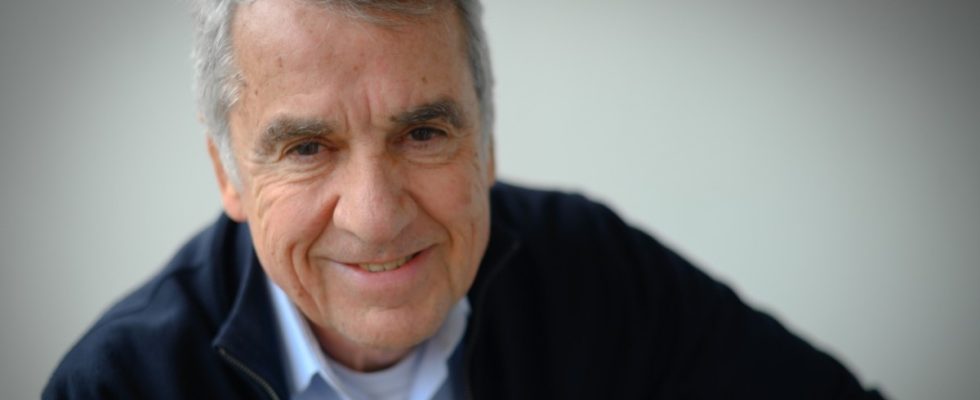Ulrich Fischer has been waiting for this moment for an hour and a half: two young women approach the light green seating object. One in blue pants and a blue sweater, the other in a pale green top. The colors of the dresses match perfectly with the objects that Fischer has his eye on from the balustrade in the Pinakothek der Moderne. And then what he wants happens: the women sit down. One directly into the greenish seat sculpture, the other close to it. Fischer presses the shutter button. At this moment he not only manages to create a color-coherent image, the supporting column of the house and the steps of the large staircase in the foyer form contrasting lines to the curves of the objects. Fischer will call the photograph “Blue and Green.” He is happy with it, his persistence has paid off.
The two women are now part of a work of art. They only sat briefly as shown in the photo. Fischer doesn’t know why they decided to take a break there. The two of them, in turn, are not aware that they have been photographed by him. You can hardly recognize their faces. Fischer assumes they agree.
The picture is one of almost 40 photographs that Fischer finds good enough to make prints of. 33 are currently on display in the Seidlvilla. They have been created since March 2022 in Munich museums and while traveling through Europe. He calls this project “Museum People.” A project that has been on his mind for more than 20 years. Fischer is thus building on his past as a photographer. His first photographic works were mostly minimalist; lines and shapes have always fascinated him.
Man in front of sculpture – for the photographer Ulrich Fischer it becomes a work of art.
(Photo: Ulrich Fischer)
Ulrich Fischer was born in Wuppertal, studied economics and social sciences in Bonn and Innsbruck and received his doctorate. He worked for banks and at the authors’ film publishing house, then increasingly concentrated on photography. As early as 1981 he exhibited in the city’s artists’ workshop at Lothringer Straße 13. In the early 1980s, a scholarship for film distribution brought him to the USA, his focus: Hollywood. Back in Germany, he became self-employed as a filmmaker, wrote scripts, directed television productions and also appeared in front of the camera as an actor.
“Not an easy time,” he said in an interview for the art magazine Stayinart. What was interesting to him was that he found film and photography to be “quite different media” at the time. In his years of filming, apart from a few small commissioned works and family photos, he hardly took any sophisticated photos. Fischer didn’t see himself having a career as a photographer or in the film business. And with digitalization, his darkroom knowledge was no longer worth much. He continued his education in the areas of physical therapy, team and organizational development. Since 1990 he has been working as a trainer, coach and supervisor with people whom he would like to help with his experience. He has had many orders from large companies and industry, he says, but he is now taking fewer jobs; he is 77 years old.

The museum guard and the bust: two heads that look alike.
(Photo: Ulrich Fischer)
Fischer is a keen observer who seeks aesthetics. He now always has his camera with him when he goes through museums. He took photographs in the Freising Diocesan Museum, in the Munich Pinakothek, the Glyptothek, and in the Haus der Kunst. Since cell phones have been used for more than just communication, no one is bothered by people taking photos anymore. Fischer has never been asked what he does. He takes photos more discreetly than many selfie posers. The art copyright law gives him certain freedoms. “Portraits from the area of contemporary history” and “images in which the people only appear as accessories next to a landscape or other location” do not require consent.
He doesn’t always ask for permission
Sometimes he speaks to people and asks them for permission. But sometimes he doesn’t dare to disturb the visitor, says Fischer. Above all, he doesn’t want to destroy the image they offer him. The one about the lady with the colorful skirt, for example, whose colors matched perfectly with the big ball at a textile exhibition. She only gave Fischer a few seconds before she disappeared. The woman in Portugal also only stood briefly behind the floating sculpture, so that it looked like a mask. Fischer looks for patterns, colors and shapes in people, in houses and in exhibition objects. When he succeeds in creating relationships between the viewer and the art with his pictures, he is happy. It was bad for him if he couldn’t react quickly enough. Missed motives or situations haunted him for a long time.
“Museum People”, can be seen until December 22nd, 2023 in the Seidlvilla, Nikolaiplatz 1b, daily from 12 p.m. to 7 p.m., except 25/26. November. Tour on Sunday, December 3rd, 2 p.m.; seidlvilla.de

